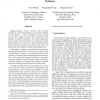Free Online Productivity Tools
i2Speak
i2Symbol
i2OCR
iTex2Img
iWeb2Print
iWeb2Shot
i2Type
iPdf2Split
iPdf2Merge
i2Bopomofo
i2Arabic
i2Style
i2Image
i2PDF
iLatex2Rtf
Sci2ools
ICDCS
2007
IEEE
2007
IEEE
mTreebone: A Hybrid Tree/Mesh Overlay for Application-Layer Live Video Multicast
Application-layer overlay networks have recently emerged as a promising solution for live media multicast on the Internet. A tree is probably the most natural structure for a multicast overlay, but is vulnerable in the presence of dynamic end-hosts. Data-driven approaches form a mesh out of overlay nodes to exchange data, which greatly enhances the resilience. It however suffers from an efficiency-latency tradeoff, given that the data have to be pulled from mesh neighbors with periodical notifications. In this paper, we suggest a novel hybrid tree/mesh design that leverages both overlays. The key idea is to identify a set of stable nodes to construct a tree-based backbone, called treebone, with most of the data being pushed over this backbone. These stable nodes, together with others, are further organized through an auxiliary mesh overlay, which facilitates the treebone to accommodate node dynamics and fully exploit the available bandwidth between overlay nodes. This hybrid design,...
Application-layer Overlay Networks | Distributed And Parallel Computing | ICDCS 2007 | Overlay Nodes | Stable Nodes |
| Added | 03 Jun 2010 |
| Updated | 03 Jun 2010 |
| Type | Conference |
| Year | 2007 |
| Where | ICDCS |
| Authors | Feng Wang, Yongqiang Xiong, Jiangchuan Liu |
Comments (0)

